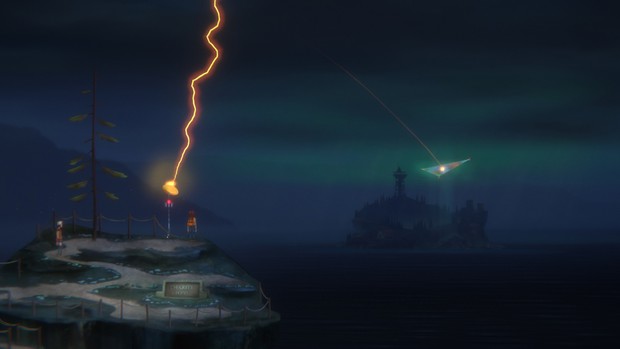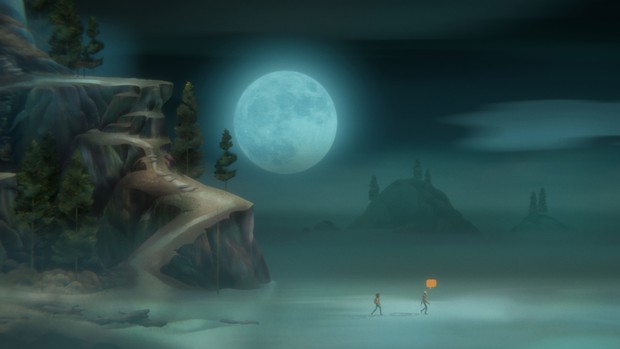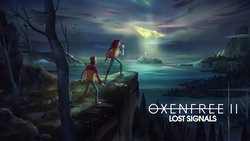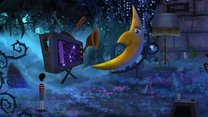Oxenfree II: Lost Signals review – Longer, more complex narrative sequel not quite as finely tuned as its predecessor

- 0 Comments
Night School Studio’s Oxenfree was a pleasant little surprise when it launched in 2016. Telling a supernatural tale amidst artful environments filled with authentic-sounding dialogue, the game became a cult hit and all (except one) of its multiple endings left room for a sequel. Seven real years – and five game years – later, that follow-up has arrived in the form of Lost Signals. The new game subscribes to the “more of the same, but different” formula for sequels, offering a very similar experience to its predecessor but with a few wrinkles thrown in. Some of those changes are for the better, while others prove less effective, though none will fundamentally change the opinion of returning players in either the love-it or hate-it camp of the original. Either way, it’s another beautiful, slow-paced, extremely verbose and at times mind-blowing paranormal mystery with little actual gameplay for an adventure named after a famous children’s game phrase.
If you haven’t played it or simply need a refresher, Oxenfree saw a teenager named Alex attend the annual beach party on Edwards Island with her stepbrother. Only a few others showed up, however, namely Alex’s long-time friend and an icy nemesis who brought her own quiet friend along. The island was once a military base that has since become a museum to honor the victims of a sunken submarine from World War II. But it is also the source of many strange phenomena, particularly those transmitted through radio signals, whose frequencies any intrepid ghost hunter can tune into on a handheld transistor. Alex is a skeptic, but soon finds herself swept up in a mystery that transcends time and space and any other known earthly dimensions, all while trying to balance the intricate nuances of tangled teen relationships.
I enjoyed roaming the painterly 2.5D environments of Oxenfree, and was very impressed with how natural the dialogue sounded and flowed seamlessly together like a real conversation between overstimulated young people. And while the supernatural goings-on proved to be a slow burn that was more confusing than enlightening for much of the game’s four-hour runtime, when it did finally pick up I was riveted by its revelations. It wasn’t a perfect experience, mind you, as navigating Edwards Island could be interminably slow, characters I didn’t particularly care for rarely seemed to shut up, and there really wasn’t a whole lot to DO except trudge from one place to another, listen to endless gabbing and occasionally pitch in with choices that would impact how relationships evolved and the story played out. In terms of player participation, the only real highlights were the opportunities to pull out a handheld radio in predetermined places and dial into eerie transmissions from the other side.

Lost Signals leans heavily into what worked the first time around but changes the cast and tweaks the setting slightly. It still takes place in the Pacific Northwest mountains of Oregon, within sight of the distant Edwards Island off the coast, but this time the protagonist is the husky-voiced, NOT-forty-five-year-old (so she claims) Riley, who arrives back in her old romping grounds carrying plenty of personal baggage. She’s here to help study electromagnetic interference emanating from Edwards by placing four transmitters at the highest available points of elevation in the wilderness surrounding the small town of Camena Coast. This means a whole lot more trekking through an even bigger, more labyrinthine environment, some of which can only be accessed after acquiring and placing the proper ropes for traversing otherwise impassable terrain. There is once again a zoomable map that will fill in with helpful details and highlight exit passages from the current location, but to my great frustration it still can’t be used for quick travel between distant points – an entirely intentional but equally un-user-friendly design decision when a certain amount of drawn-out backtracking is inevitable.
The reason for making players hoof it everywhere on foot (via gamepad or simple point-and-click) is all the yakking that happens along the way. As before, you’ll have a companion for most of your journey; this time it’s Jacob, an old barely-an-acquaintance from high school who never left the area and is now questioning his life choices. Jacob’s a very nice guy who good-naturedly absorbs the cold shoulder from Riley – you have the option to shape Riley’s attitude towards him and others, but even her nicest is generally aloof at best – but man, does that boy talk! The dialogue itself is once again first rate, gradually unpeeling new layers and touching on some very adult themes that befit the older ages of the characters in an organic-feeling way. The problem (shared with the original Oxenfree) is that much of it seems out of touch with the spookier events taking place. The interpersonal conversations would fit perfectly at a high school reunion, or over coffee between people catching up on the years since they’d seen each other last, but far less so crammed in between dramatically life-altering experiences that would surely take up all the oxygen in the room.
Jacob’s not the only one with things to say, either. Along with the presence of a few local teens with agendas of their own, another change between games is that Riley comes equipped with a walkie-talkie that lets her converse with various others, from her night watch supervisor to a retired fisherman seeking adventure to a nearby forest ranger. Some are optional, but as these tend to focus more on the supernatural events occurring around you, I felt more in tune (no pun intended, though you do need to change channels to communicate with each individual person) with these remote exchanges than many of the background conversations with Jacob. And yet I’d often cringe when the crackle of the walkie-talkie signaled another incoming message, simply because they cut further into any precious moments of silence. There’s no bad dialogue in Lost Signals, and the voice acting is consistently excellent from everyone involved. There’s just an overabundance of it under the circumstances, and rarely do people sound as freaked out by what’s happening as they should be.

The paranormal events on Camena are much like the ones on Edwards Island. At the most unexpected (and occasionally inopportune) times, the screen will start to glitch with static and you’ll suddenly find yourself yanked out of your current reality and thrust into another time or place with people you may or may not know, or find that someone close to you has been temporarily possessed in order to convey ominous , hard-to-distinguish ghostly messages spliced together from radio programs like a spectral version of Bumblebee the Transformer. These scenes are often so bewildering that I suspect even David Lynch would offer up a “WTF!” in response, and to an extent I gave up on even trying to bother making sense of them. And yet slowly but not-so-surely you do begin to piece together who is causing these disturbances and why, including a few plot twists that pull the rug out from under you and link Lost Signals with its predecessor.
As in the first game, none of these scenes are particularly scary in the traditional sense, but they’re alarming enough to create a genuine sense of unease, as does the atmospheric 80s-style synth soundtrack that would feel right at home on Stranger Things. This isn’t a horror game so much as a horrible tragedy, and the fates of some of its characters are in your hands to determine. Most of the decisions you’ll make – or not make if you let the timed dialogue options run out without choosing – will simply affect your relationships with others, but there are a few key choices that have a dramatic impact on the outcome, once again creating a degree of replayability to adopt other tones and make alternate decisions. There are no right or wrong answers, only the ability to roleplay as you see fit. My own personal replies would have differed from those available fairly often, but other than a few times when the resulting dialogue was not what I anticipated, I was comfortable with my choices and feel no need or desire to play the game again to try another path. Which is good, because the autosave-only checkpoint system doesn’t allow for restoring a game without starting over from scratch.
There are other means of affecting the story as well, though only in scripted ways. The handheld radio from Oxenfree returns, but it’s used far less here until a late-game sequence that feels like too much, too late. It’s as simple as ever – just turn the radial dial until you trigger a spooky message, create a rift in the fabric of reality, or cause some other environmental affect – but I was disappointed by its diminished role, as it feels like a fun bit of electronic treasure hunting. In its place on a handful of occasions are stationary machines with four-part signal patterns that must be aligned. This may seem a bit more puzzly, but really it’s not, involving little more than additional trial and error until you zero in on the solution.

There are a couple other minor attempts to make Lost Signals feel more game-like, but for the most part these amount to nothing more than a bit of fetch work. A lock may require a key or code, for example, but they’ll be readily found at a nearby location you’re specifically directed to. The radio is no longer used to unearth hidden collectibles (or if it is, I never found where), but there are letters to find scattered about, easily spotted with their telltale sparkle. These are meant to provide helpful background info, but I found they bore no real relevance to the story and I quickly lost interest – a far cry from desperately trying to make sense of the garbled communiqués from the first game’s ghosts.
Of course, just making your way through the mazelike Camena could be considered something of a puzzle itself. As you make your way up, down, and across its winding trails, caves, waterfalls, lakes, rocky chasms, forests, and bridges, you won’t get lost but it’s not always clear which way you need to go. Occasionally the camera will zoom out automatically as you enter a new area to give you a good view of the surrounding countryside, but then it zooms back in and can’t be manually repeated. The map will help get you reoriented in the desired direction, but not necessarily with all the information required. I was pretty annoyed to traipse all the way to the entrance of an old mining ghost town, only to be turned away because my equipment needed to be upgraded. Another time I made my way to a church to head off some pesky cult members, only to discover that I was supposed to be at the OTHER church halfway across the map. Lucky for that quick travel map! Wait, no. Argh! There’s no way to even get Riley and Jacob to pick up the pace a little.
Then again, it’s hard to resent soaking in the beautiful sights a little longer. Lost Signals uses the same kind of painterly art style as the first game, and the scenic views really make for a lovely backdrop, if a rather dark one as the entire story once again takes place over the course of just one night. (Not counting a few rift-inspired detours to daytime settings.) Curiously, there seems to be a slight haze over everything that wasn’t there in Oxenfree. It’s so noticeable that I actually checked my visual settings to make sure I had them all cranked up – I did, so I can only assume the effect is intentional. It does make things slightly more dreamlike, if that was the goal, but I missed the crispness of the first game.
I can’t say much about the story itself, of course, both for fear of spoilers and because I couldn’t make heads or tails out of most of it. In trying to weave together the narratives of the original game’s cast both living and dead, it makes for a thoughtful connection between games but risks alienating newcomers and feels like a bridge too far. There are so many names and times and places involved that it all ends up feeling frustratingly jumbled rather than an intriguing mystery to piece together. The larger map and added content bring the total playtime of a single playthrough to about six hours, and for returning players the ending provides a proper closure withheld the last time around. At least, my ending did; as before there are multiple endings possible for those who wish to experiment.
Final Verdict
Fans of the original Oxenfree should largely enjoy the bigger, longer sequel, with the caveat that more isn’t always better. I preferred the older, more mature characters this time around, and once again the writing and production values are excellent for the most part. A (very little) bit of expanded gameplay is welcome, while the complexity of weaving two stories together ends up feeling too convoluted for its own good. While you could easily skip the first game if you wish, you’d probably get more out of this one if you don’t. And since the tighter, leaner original is marginally better than the sequel, there’s really no reason not to start there anyway. The novelty is missing the second time around, but if you’re all about story, exploration and characters, you’ll likely find that both Oxenfree and Lost Signals are worth picking up.
Hot take
Bigger and better than its predecessor in some ways, more bloated and less focused in others, Oxenfree II: Lost Signals is an intriguing sequel for those on the right wavelength for this kind of gameplay-lite narrative experience.
Pros
- Mature, well-written and superbly voiced dialogue between adult protagonists
- Beautiful painterly mountain environments to explore
- Supernatural phenomena are genuinely unsettling
Cons
- Interpersonal dialogue can feel excessive and doesn’t always suit the circumstances
- Very little gameplay to speak of
- No way to speed up backtracking
Jack played Oxenfree II: Lost Signals on PC using a review code provided by the game's publisher.











0 Comments
Want to join the discussion? Leave a comment as guest, sign in or register in our forums.
Leave a comment